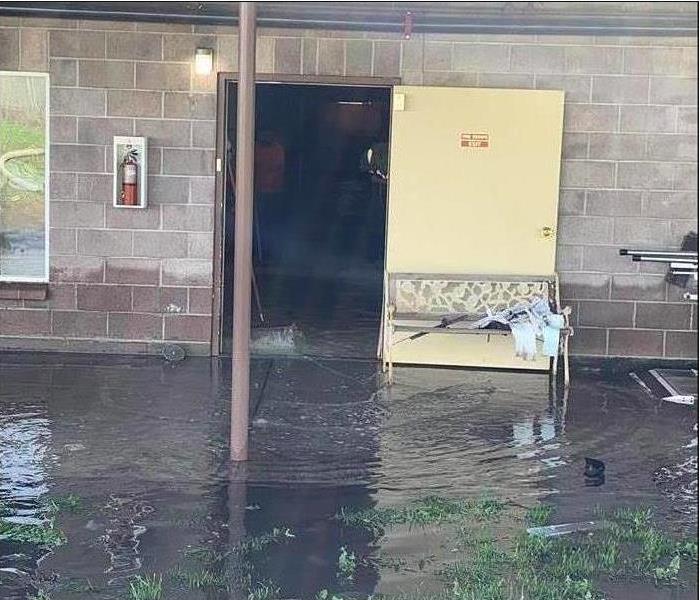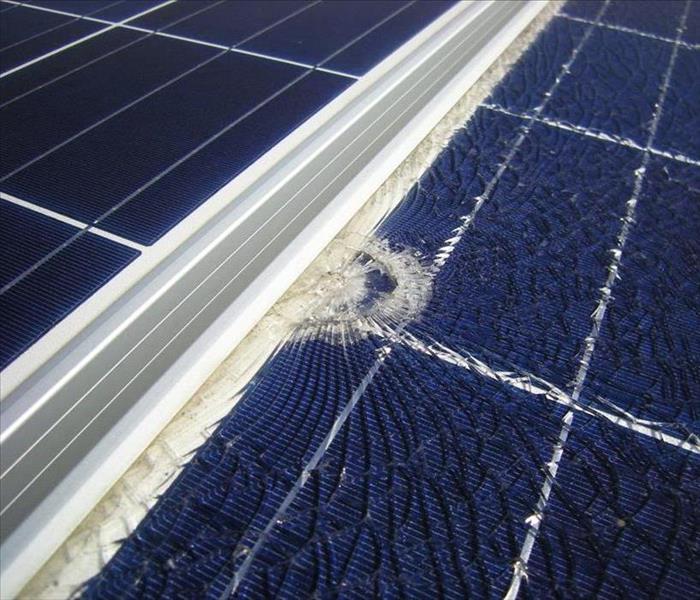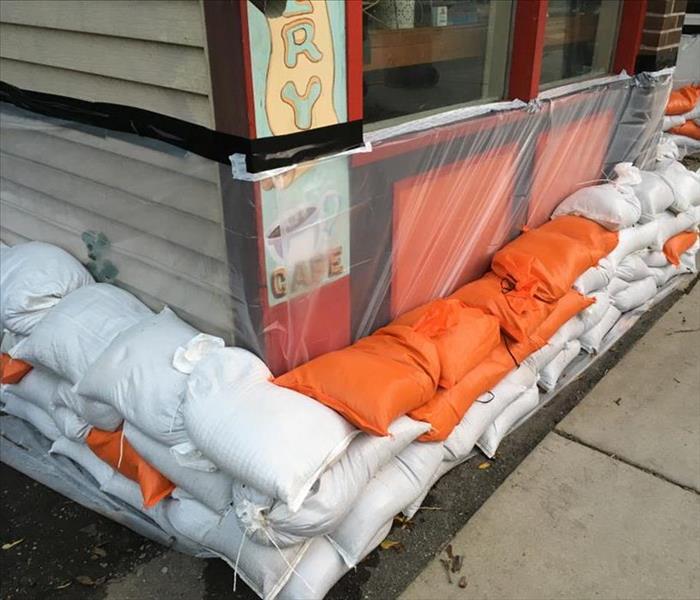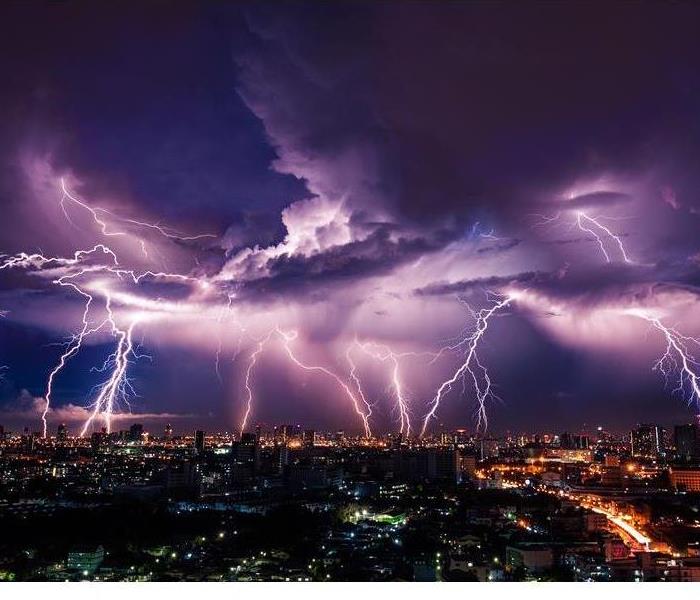Archived Storm Damage Blog Posts
Odor Removal Following a Flood
7/8/2022 (Permalink)
 Odor Removal Following a Flood
Odor Removal Following a Flood
Cleaning Up After a Flood
Mold growth and sewage loss are severe complications following a septic system backup that causes a flood at your business in Olympia, WA. Although powerful water extraction methods can quickly dry your space, more drastic efforts are necessary for sanitization and odor removal.
Problems Following a Flood
Water that floods your business following a severe storm or plumbing damage requires careful handling because it may contain:
- Salmonella
- Tetanus
- Hepatitis A
- Sewage
- Parasites
Flood water at your business requires prompt removal before mold problems develop. Mold spores that quickly spread through the air are not visible, but you can detect them in your building by the musty odor they produce. Fortunately, knowledgeable mold remediation professionals can undertake odor removal efforts that purify the air.
Odor Removal Methods
The first step toward eliminating the odor that follows a flood involves air filtration. This technique involves industrial-grade HEPA vacuums that capture microscopic spores in the air and prevents them from spreading.
Mold growth and other contaminants leave behind stubborn odors, but ozone generators provide one of the most effective treatments for removing them. This method involves introducing ozone molecules into the contaminated space. Ozone is an oxygen molecule that has three rather than two oxygen atoms. The third atom breaks away from the others, attaches itself to the atom producing the offensive odor, and neutralizes it.
It is necessary to evacuate the premises while ozone treatment is underway and until the oxygen molecules in the atmosphere return to their normal levels.
Air fogging is another method that involves heating a deodorizing solvent and releasing it into the atmosphere as a mist. It is particularly effective for accessing the difficult-to-reach areas behind walls, under floorboards or within upholstery fibers and leaves behind a pleasant odor.
Odor removal professionals have the knowledge and skills to address unpleasant odors resulting from mold growth and sewage loss following a flood from a septic system backup at your business in Olympia, WA.
Top 4 Causes of Solar Panel Damage
6/29/2022 (Permalink)
 If you're considering solar energy for your house, you may be concerned about panel damage in the face of a storm.
If you're considering solar energy for your house, you may be concerned about panel damage in the face of a storm.
Top 4 Solar Panel Damage Causes
Solar panels are a popular energy alternative for many homeowners in Yelm, WA. Despite the upfront investment, these panels are cost-efficient over the long haul. If you're considering solar energy for your house, you may be concerned about panel damage in the face of a storm. Below are the weather events that are the most likely to cause damage.
1. Hurricanes
Generally, solar panel technology is designed to handle severe weather conditions, including hurricanes. In fact, panels remain intact when exposed to winds as high as 140 miles per hour. However, there are cases in which panels become dislodged.
2. Rain and Floods
In some cases, rain and floods can do more panel damage than hurricane winds. The metal casings covering the panel wires are most damage prone. Roof damage is more likely with persistent rain and flooding post-hurricane. Under these conditions, the panels can also become loose.
3. Hail Storms
Many solar panel systems can hold up well under pounding hail downpours. Manufacturers factor in volatile weather when they design these panels. In most instances, the panels can handle one-inch hail that comes down at 50 miles per hour. If damage does occur, it may only affect one or two panels. However, constant hail hitting the same panel can result in major damage.
4. Debris
Despite the intensity of hurricanes, floods, rain and hail, they don't always cause the most damage. Often, the greatest panel damage comes from falling debris during storms. For example, trees falling on the panels can cause more significant damage than weather events.
Surviving the Storm
Generally, solar panels are built to handle a variety of extreme weather conditions. Minor damage can occur as a result of hurricanes, floods, heavy rains and floods. Nevertheless, falling debris tends to cause the greatest damage. Panels can become loose or dislodged resulting in water damage in your home. If this occurs, consider hiring a cleaning and restoration company.
3 Steps to Filing a Flood Damage Claim
6/24/2022 (Permalink)
How to File a Flood Damage Claim in 3 Easy Steps
A flood in Olympia, WA, is a life-changing event. After a natural disaster like that, you want to return your life back to normal. One of the most important ways to do that is by filing a flood claim. There are a few simple steps to follow to ensure the process is completed without delay.
1. Contact Insurance Provider
Get in contact with your insurance company or agent immediately after the flood. Provide basic information, such as your policy number along with a phone number and email address. You want to make sure you can be reached at any time. An insurance adjuster will be scheduled to visit your home within a few days to assess the flood claim damages.
2. Document Damages
An insurance adjuster needs a clear picture of how much flood damage occurred in your home. Prior to the adjuster's visit, spend a day or two taking photographs, recording videos and making a list of all the damages. Here are the most common things to document:
• Standing flood water levels
• Discarded objects
• Lost items
• Property and structural damage
Take note of anything affected by the flood. Whenever possible, provide receipts, value and purchase date of damaged or lost items. The more detailed information you provide, the better able the adjuster will be to prepare a repair estimate.
3. Consult With the Adjuster
An insurance adjuster can walk you through the insurance claim process. He or she can tell you what your homeowners' policy does and doesn't cover as relates to the flood. Once all the necessary paperwork is submitted, processed and proven accurate, the next step is that you'll receive payment.
A Return to Normal
A house flood is a stressful experience. However, things can return to normal quickly when you follow the simple steps for filing a flood claim. Once the claim process is completed, you can begin rebuilding your life. Often this involves hiring a restoration company to clean up the mess the disaster left behind.
Preparing Your Commercial Building for a Flood
4/1/2022 (Permalink)
 If you need a flood cleanup after a storm, don't try to tackle the problem yourself. calling SERVPRO is the best solution.
If you need a flood cleanup after a storm, don't try to tackle the problem yourself. calling SERVPRO is the best solution.
Flood Preparation For Your Commercial Building
If your business in Olympia, WA, is located in or near a high flood zone, flood insurance is a must. Flood insurance is available through the National Flood Insurance Program (NFIP) and can be added to your commercial building insurance plan. There are some flood prevention techniques you should also consider to reduce the risk of flooding.
1. Determine Your Base Flood Elevation
This calculation, known as the BFE, determines if your lowest floor is above or below the acceptable flood level. If it is below acceptable levels consider elevating the building at least 3 feet above the BFE, if possible. Contact your county's floodplain administrator for details in determining your BFE.
2. Install Flood-Resistant Materials
Use materials that are flood-resistant wherever possible. Water-resistant wall coverings, flooring and wall insulation will reduce the risk of water damage. Most of these materials can handle contact with water for about 72 hours before extensive damage occurs.
3. Utilize Dry Floodproofing Techniques
Flood prevention techniques, such as dry floodproofing, help to make your building watertight and keep floodwaters from invading your building.
Water-resistant shields should be placed over doors and windows located at or below the BFE. Water-absorbent sandbags, plastic tarps and sheeting should be placed in strategic areas around the building before the storm hits. These devices help to stave off shallow floodwaters.
Permanent swing flood doors or temporary flood gates can be installed to prevent deeper water from entering your building.
4. Invest in Backup Electrical Power
Consider purchasing backup power for your mechanical equipment and air conditioning system. Humidifiers and blowers help dry out materials quickly. If you find yourself in need of flood cleaning after a storm, however, don't attempt to tackle the problem yourself. Contact a water restoration service as soon as possible.
By implementing some smart flood prevention techniques, you can reduce the risk of severe damage to your building.
4 Storm Preparation Measures for Property Managers
3/16/2022 (Permalink)
 For the best results, storm preparedness should be a constant property management effort.
For the best results, storm preparedness should be a constant property management effort.
Property Managers Should Take These 4 Storm Preparation Steps
Property management can take measures to prepare for storms that may limit the amount of damage sustained by a commercial building. Here are four steps toward storm preparedness that owners or managers can take on a seasonal basis or whenever severe weather is on the forecast for Olympia, WA.
1. Check Doors and Windows
Many storms involve high winds. Exterior doors with worn flashing, sealant or tracks may be prone to blow open. This can quickly introduce rain and debris to a building interior and result in damage. Building owners and managers should make sure that doors close completely and windows are waterproof.
2. Clear Drainage
A functional drainage system is another crucial part of storm preparedness. Make sure that roof drains, gutters and downspouts are clear and that water is routed away from the foundation of the structure.
3. Trim Trees
Falling tree limbs can severely damage the roof of a building and result in damage to the interior. Owners or managers of properties with tall trees that have overhanging branches should contact a tree trimming service prior to storms with high winds or heavy snow and ice.
4. Secure Outdoor Items
Wind gusts can turn outdoor items such as patio furniture or trashcans into dangerous flying debris. Items may be fastened down or temporarily stored indoors. Don't forget about items on the roof. It may be a good idea to disconnect antennas or other equipment and store these items inside until the storm passes.
For the best results, storm preparedness should be a constant property management effort. Owners and managers may not have enough warning to take all of these steps prior to a major storm in Olympia, WA. It is a good idea to develop and follow a seasonal storm preparation plan to limit damage. If a structure suffers storm damage, contact commercial mitigation and restoration experts.

 24/7 Emergency Service
24/7 Emergency Service


